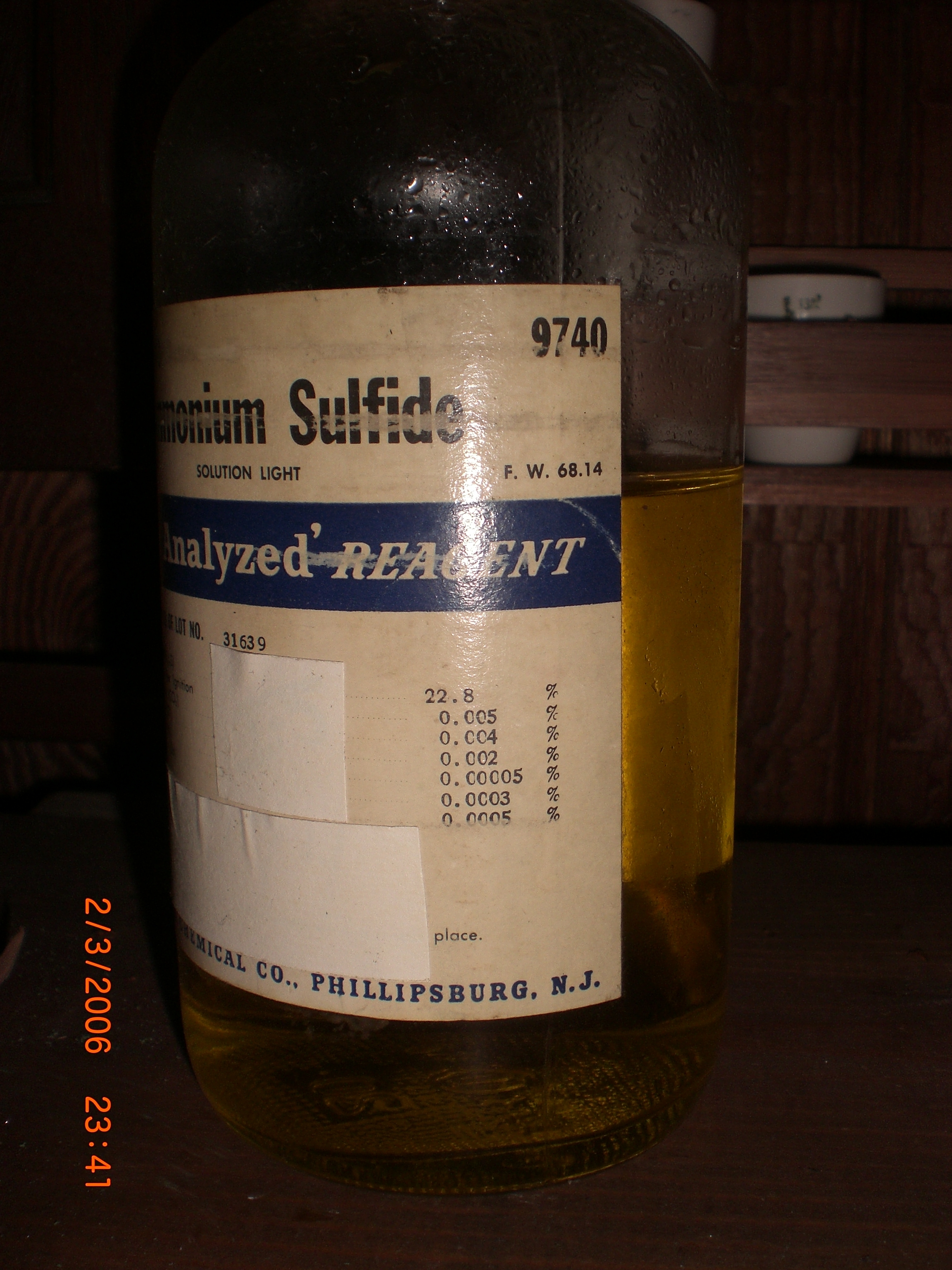Ammonium hydrosulfide on:
[Wikipedia]
[Google]
[Amazon]
Ammonium hydrosulfide is the
 Aqueous solutions of ammonium sulfide (CAS registry number ), also known as diammonium sulfide are commercially available, although the composition of these solutions is uncertain as they could consist of a mixture of ammonia and . Ammonium sulfide solutions are used occasionally in photographic developing, to apply patina to bronze, and in
Aqueous solutions of ammonium sulfide (CAS registry number ), also known as diammonium sulfide are commercially available, although the composition of these solutions is uncertain as they could consist of a mixture of ammonia and . Ammonium sulfide solutions are used occasionally in photographic developing, to apply patina to bronze, and in
chemical compound
A chemical compound is a chemical substance composed of many identical molecules (or molecular entities) containing atoms from more than one chemical element held together by chemical bonds. A molecule consisting of atoms of only one element ...
with the formula .
Composition
It is thesalt
Salt is a mineral composed primarily of sodium chloride (NaCl), a chemical compound belonging to the larger class of salts; salt in the form of a natural crystalline mineral is known as rock salt or halite. Salt is present in vast quant ...
derived from the ammonium cation and the hydrosulfide anion
An ion () is an atom or molecule with a net electrical charge.
The charge of an electron is considered to be negative by convention and this charge is equal and opposite to the charge of a proton, which is considered to be positive by conve ...
. The salt exists as colourless, water-soluble, micaceous crystals. On Earth the compound is encountered mainly as a solution, not as the solid, but ice is believed to be a substantial component of the cloud decks of the gas-giant planets Jupiter
Jupiter is the fifth planet from the Sun and the largest in the Solar System. It is a gas giant with a mass more than two and a half times that of all the other planets in the Solar System combined, but slightly less than one-thousandth t ...
and Saturn, with sulfur produced by its photolysis responsible for the color of some of those planets' clouds. It can be generated by mixing hydrogen sulfide and ammonia
Ammonia is an inorganic compound of nitrogen and hydrogen with the formula . A stable binary hydride, and the simplest pnictogen hydride, ammonia is a colourless gas with a distinct pungent smell. Biologically, it is a common nitrogenous wa ...
.
Preparation
Solutions of ammonium hydrosulfide can be prepared by passing hydrogen sulfide gas through concentratedammonia
Ammonia is an inorganic compound of nitrogen and hydrogen with the formula . A stable binary hydride, and the simplest pnictogen hydride, ammonia is a colourless gas with a distinct pungent smell. Biologically, it is a common nitrogenous wa ...
solution. According to a detailed 1895 report, hydrogen sulfide reacts with concentrated aqueous ammonia solution at room temperature to give . When this species is cooled to 0 °C and treated with additional hydrogen sulfide, one obtains . An ice-cold solution of this substance kept at 0 °C and having hydrogen sulfide continually passed through it gives the hydrosulfide.
The common " stink bomb" consists of an aqueous solution of ammonium sulfide. The mixture easily converts to ammonia
Ammonia is an inorganic compound of nitrogen and hydrogen with the formula . A stable binary hydride, and the simplest pnictogen hydride, ammonia is a colourless gas with a distinct pungent smell. Biologically, it is a common nitrogenous wa ...
and hydrogen sulfide gases. This conversion illustrates the ease of the following equilibrium:
:
Ammonia and hydrogen sulfide each have a powerful and unpleasant smell.
"Ammonium sulfide"
 Aqueous solutions of ammonium sulfide (CAS registry number ), also known as diammonium sulfide are commercially available, although the composition of these solutions is uncertain as they could consist of a mixture of ammonia and . Ammonium sulfide solutions are used occasionally in photographic developing, to apply patina to bronze, and in
Aqueous solutions of ammonium sulfide (CAS registry number ), also known as diammonium sulfide are commercially available, although the composition of these solutions is uncertain as they could consist of a mixture of ammonia and . Ammonium sulfide solutions are used occasionally in photographic developing, to apply patina to bronze, and in textile
Textile is an umbrella term that includes various fiber-based materials, including fibers, yarns, filaments, threads, different fabric types, etc. At first, the word "textiles" only referred to woven fabrics. However, weaving is not the ...
manufacturing. It can be used as a selective reducing agent (cf. 2,4-dinitrochlorobenzene
2,4-Dinitrochlorobenzene (DNCB) is an organic compound with the chemical formula (O2N)2C6H3Cl. It is a yellow solid that is soluble in organic solvents. It is an important intermediate for the industrial production of other compounds.
DNCB is p ...
); where there are two nitro groups, only one of them is selectively reduced.
The 1990-1991 '' CRC Handbook of Chemistry and Physics'' gives information for anhydrous ammonium monosulfide () and ammonium pentasulfide () as separate from anhydrous ammonium hydrosulfide (), describing the former two both as yellow crystalline substances that are soluble in cold water and alcohol, and which both decompose in hot water or at high temperature in general (115°C for the pentasulfide), but the latter as a white crystalline solid (which also decomposes in hot water). Thus, it seems that solid ammonium sulfide can be distinct from solid ammonium hydrosulfide, even if this is not true in aqueous solution.
References
{{sulfur compounds Ammonium compounds Hydrosulfides